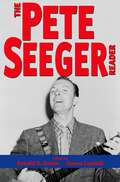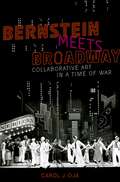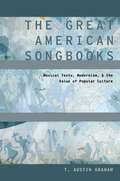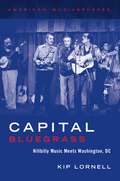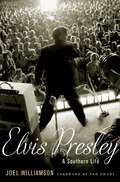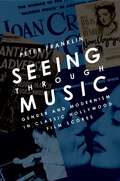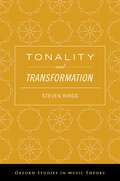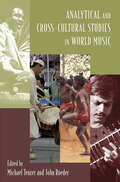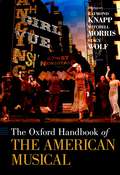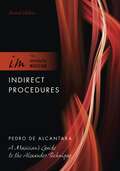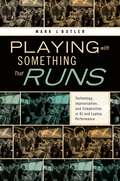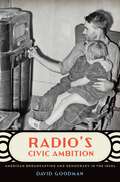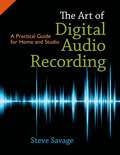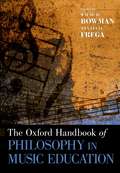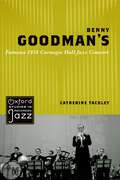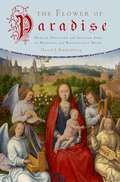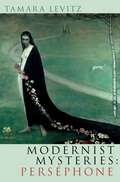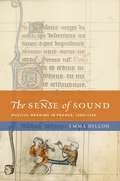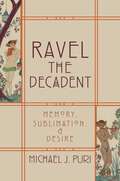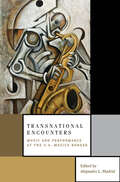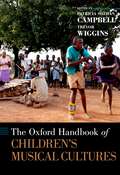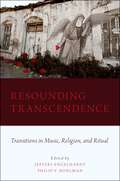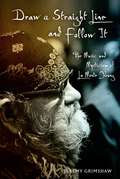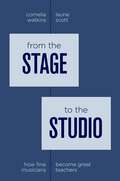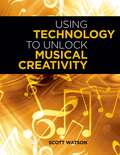- Table View
- List View
The Pete Seeger Reader (Readers on American Musicians)
by Ronald D. Cohen James CapaldiPerhaps the most widely recognized figure in folk music and one of the most well-known figures in American political activism, Pete Seeger now belongs among the icons of 20th-century American culture. The road to his current status as activist and respected voice of folk music was long and often rough, starting from the moment he dropped out of Harvard in the late 1930s and picked up a banjo. Editors Ronald Cohen and James Capaldi trace Seeger's long and storied career, focusing on his work as not only a singer, but also on his substantial contributions as an educator, songwriter, organizer, publisher, and journalist. The son of musicians, Seeger began his musical career before World War II and became well-known in the 1950s as a member of the commercially popular Weavers, only to be blacklisted by much of the mainstream media in the 1960s because of his progressive politics, and to return to the music scene in subsequent decades as a tireless educator and activist. The Pete Seeger Reader gathers writings from numerous sources, mixing Seeger's own work with that of the many people who have, over the years, written about him. Many of the pieces have never before been republished, and cover his entire career. A figure of amazing productivity, influence, and longevity, Seeger is author of a life that has been both cast in heroic terms and vilified. The selections in this book draw from a full range of these perspectives and will inform as they entertain, bringing into focus the life and contributions of one of the most influential figures of the twentieth century.
Bernstein Meets Broadway: Collaborative Art in a Time of War (Broadway Legacies)
by Carol J. OjaWinner of the 2015 Music in American Culture Award from the American Musicological Society When Leonard Bernstein first arrived in New York City, he was an unknown artist working with other brilliant twentysomethings, notably Jerome Robbins, Betty Comden, and Adolph Green. By the end of the 1940s, these artists were world famous. Their collaborations defied artistic boundaries and subtly pushed a progressive political agenda, altering the landscape of musical theater, ballet, and nightclub comedy. In Bernstein Meets Broadway: Collaborative Art in a Time of War, award-winning author and scholar Carol J. Oja examines the early days of Bernstein's career during World War II, centering around the debut in 1944 of the Broadway musical On the Town and the ballet Fancy Free. As a composer and conductor, Bernstein experienced a meteoric rise to fame, thanks in no small part to his visionary colleagues. Together, they focused on urban contemporary life and popular culture, featuring as heroes the itinerant sailors who bore the brunt of military service. They were provocative both artistically and politically. In a time of race riots and Japanese internment camps, Bernstein and his collaborators featured African American performers and a Japanese American ballerina, staging a model of racial integration. Rather than accepting traditional distinctions between high and low art, Bernstein's music was wide-open, inspired by everything from opera and jazz to cartoons. Oja shapes a wide-ranging cultural history that captures a tumultuous moment in time. Bernstein Meets Broadway is an indispensable work for fans of Broadway musicals, dance, and American performance history.
The Great American Songbooks: Musical Texts, Modernism, and the Value of Popular Culture (Modernist Literature and Culture)
by T. Austin GrahamIn the late nineteenth and early twentieth centuries, American authors pioneered a mode of musical writing that quite literally resounded beyond the printed page. Novels gained soundtracks, poetry compelled its audiences to sing, and the ostensibly silent act of reading became anything but. The Great American Songbooks is the story of this literature, at once an overview of musical and authorial practice at the century's turn, an investigation into the sensory dimensions of reading, and a meditation on the effects that the popular arts have had on literary modernism. The writings of John Dos Passos, Theodore Dreiser, T.S. Eliot, F. Scott Fitzgerald, Langston Hughes, Jean Toomer, and Walt Whitman are heard in a new key; the performers and tunesmiths who inspired them have their stories told; and the music of the past, long out of print and fashion, is recapitulated and made available in digital form. A work of criticism situated at the crossroads of literary analysis, musicology, and cultural history, The Great American Songbooks demonstrates the importance of studying fiction and poetry from interdisciplinary perspectives, and it suggests new avenues for research in the dawning age of the digital humanities.
Capital Bluegrass: Hillbilly Music Meets Washington, DC (American Musicspheres)
by Kip LornellWith its rich but underappreciated musical heritage, Washington, D.C. is often overlooked as a cradle for punk, the birthplace of go go, and as the urban center for bluegrass in the Untied States. Capital Bluegrass: Hillbilly Music Meets Washington, D.C. richly documents the history and development of bluegrass in and around the nation's capital since it emerged in the 1950s. In his seventeenth book, American vernacular music scholar Kip Lornell discusses both well-known progressive bluegrass bands including the Country Gentlemen and the Seldom Scene, and lesser known groups like the Happy Melody Boys, Benny and Vallie Cain and the Country Clan, and Foggy Bottom. Lornell focuses on colorful figures such as the brilliant and eccentric mandolin player, Buzz Busby, and Connie B. Gay, who helped found the Country Music Association in Nashville. Moving beyond the musicians to the institutions that were central to the development of the genre, Lornell brings the reader into the nationally recognized Birchmere Music Hall, and tunes in to NPR powerhouse WAMU-FM, which for five decades broadcast as much as 40 hours a week of bluegrass programming. Dozens of images illuminate the story of bluegrass in the D.C. area, photographs and flyers that will be new to even the most veteran bluegrass enthusiast. Bringing to life a music and musical community integral to the history of the city itself, Capital Bluegrass tells an essential tale of bluegrass in the United States.
Elvis Presley: A Southern Life
by Joel WilliamsonIn Elvis Presley: A Southern Life, one of the most admired Southern historians of our time takes on one of the greatest cultural icons of all time. The result is a masterpiece: a vivid, gripping biography, set against the rich backdrop of Southern society--indeed, American society--in the second half of the twentieth century. Author of The Crucible of Race and William Faulkner and Southern History, Joel Williamson is a renowned historian known for his inimitable and compelling narrative style. In this tour de force biography, he captures the drama of Presley's career set against the popular culture of the post-World War II South. Born in Tupelo, Mississippi, Presley was a contradiction, flamboyant in pegged black pants with pink stripes, yet soft-spoken, respectfully courting a decent girl from church. Then he wandered into Sun Records, and everything changed. "I was scared stiff," Elvis recalled about his first time performing on stage. "Everyone was hollering and I didn't know what they were hollering at." Girls did the hollering--at his snarl and swagger. Williamson calls it "the revolution of the Elvis girls." His fans lived in an intense moment, this generation raised by their mothers while their fathers were away at war, whose lives were transformed by an exodus from the countryside to Southern cities, a postwar culture of consumption, and a striving for upward mobility. They came of age in the era of the 1954 Brown vs. Board of Education ruling, which turned high schools into battlegrounds of race. Explosively, white girls went wild for a white man inspired by and singing black music while "wiggling" erotically. Elvis, Williamson argues, gave his female fans an opportunity to break free from straitlaced Southern society and express themselves sexually, if only for a few hours at a time. Rather than focusing on Elvis's music and the music industry, Elvis Presley: A Southern Life illuminates the zenith of his career, his period of deepest creativity, which captured a legion of fans and kept them fervently loyal for decades. Williamson shows how Elvis himself changed--and didn't. In the latter part of his career, when he performed regular gigs in Las Vegas and toured second-tier cities, he moved beyond the South to a national audience who had bought his albums and watched his movies. Yet the makeup of his fan base did not substantially change, nor did Elvis himself ever move up the Southern class ladder despite his wealth. Even as he aged and his life was cut short, he maintained his iconic status, becoming arguably larger in death than in life as droves of fans continue to pay homage to him at Graceland. Appreciative and unsparing, culturally attuned and socially revealing, Williamson's Elvis Presley will deepen our understanding of the man and his times.
Seeing Through Music: Gender and Modernism in Classic Hollywood Film Scores (Oxford Music / Media)
by Peter FranklinHollywood film music is often mocked as a disreputably 'applied' branch of the art of composition that lacks both the seriousness and the quality of the classical or late-romantic concert and operatic music from which it derives. Its composers in the 1930s and '40s were themselves often scornful of it and aspired to produce more 'serious' works that would enhance their artistic reputation. In fact the criticism of film music as slavishly descriptive or manipulatively over-emotional has a history that is older than film - it had even been directed at the relatively popular operatic and concert music written by some of the émigré Hollywood composers themselves before they had left Europe. There, as subsequently in America, such criticism was promoted by the developing project of Modernism, whose often high-minded opposition to mass culture used polarizing language that drew, intentionally or not, upon that of gender difference. Regressive, late-romantic music, the old argument ran, was -- as women were believed to be -- emotional, irrational, and lacking in logic. This book seeks to level the critical playing field between film music and "serious music," reflecting upon gender-related ideas about music and modernism as much as about film. Peter Franklin broaches the possibility of a history of twentieth-century music that would include, rather than marginalize, film music -- and, indeed, the scores of a number of the major Hollywood movies discussed here, like The Bride of Frankenstein, King Kong, Rebecca, Gone With The Wind, Citizen Kane and Psycho. In doing so, he brings more detailed music-historical knowledge to bear upon cinema music, often discussed as a unique and special product of film, and also offers conclusions about the problematic aspects of musical modernism and some arguably liberating aspects of "late-romanticism."
Tonality and Transformation (Oxford Studies in Music Theory)
by Steven RingsTonality and Transformation is a groundbreaking study in the analysis of tonal music. Focusing on the listener's experience, author Steven Rings employs transformational music theory to illuminate diverse aspects of tonal hearing - from the infusion of sounding pitches with familiar tonal qualities to sensations of directedness and attraction. In the process, Rings introduces a host of new analytical techniques for the study of the tonal repertory, demonstrating their application in vivid interpretive set pieces on music from Bach to Mahler. The analyses place the book's novel techniques in dialogue with existing tonal methodologies, such as Schenkerian theory, avoiding partisan debate in favor of a methodologically careful, pluralistic approach. Rings also engages neo-Riemannian theory-a popular branch of transformational thought focused on chromatic harmony-reanimating its basic operations with tonal dynamism and bringing them into closer rapprochement with traditional tonal concepts. Written in a direct and engaging style, with lively prose and plain-English descriptions of all technical ideas, Tonality and Transformation balances theoretical substance with accessibility: it will appeal to both specialists and non-specialists. It is a particularly attractive volume for those new to transformational theory: in addition to its original theoretical content, the book offers an excellent introduction to transformational thought, including a chapter that outlines the theory's conceptual foundations and formal apparatus, as well as a glossary of common technical terms. A contribution to our understanding of tonal phenomenology and a landmark in the analytical application of transformational techniques, Tonality and Transformation is an indispensible work of music theory.
Analytical and Cross-Cultural Studies in World Music
by Michael Tenzer John RoederThis collection presents intriguing explanations of extraordinary musical creations from across the world, concentrating on how the music works as sound in process. It suggests analytical approaches that apply across cultures, proposes a new way of classifying music, and treats provocative questions about the juxtaposition of music from different cultures.
The Oxford Handbook of The American Musical (Oxford Handbooks)
The Oxford Handbook of The American Musical offers new and cutting-edge essays on the most important and compelling issues and topics in the growing, interdisciplinary field of musical-theater and film-musical studies. Taking the form of a "keywords" book, it introduces readers to the concepts and terms that define the history of the musical as a genre and that offer ways to reflect on the specific creative choices that shape musicals and their performance on stage and screen. The handbook offers a cross-section of essays written by leading experts in the field, organized within broad conceptual groups, which together capture the breadth, direction, and tone of musicals studies today. Each essay traces the genealogy of the term or issue it addresses, including related issues and controversies, positions and problematizes those issues within larger bodies of scholarship, and provides specific examples drawn from shows and films. Essays both re-examine traditional topics and introduce underexplored areas. Reflecting the concerns of scholars and students alike, the authors emphasize critical and accessible perspectives, and supplement theory with concrete examples that may be accessed through links to the handbook's website. Taking into account issues of composition, performance, and reception, the book's contributors bring a wide range of practical and theoretical perspectives to bear on their considerations of one of America's most lively, enduring artistic traditions. The Oxford Handbook of The American Musical will engage all readers interested in the form, from students to scholars to fans and aficionados, as it analyses the complex relationships among the creators, performers, and audiences who sustain the genre.
Indirect Procedures: A Musician's Guide to the Alexander Technique (The Integrated Musician)
by Pedro de AlcantaraA musician's life is filled with many stressful situations: passing auditions, rehearsing and performing with difficult partners, sitting for long hours in uncomfortable chairs, going on stage to face audiences large and small, who may or may not be receptive to the performance they are presented. And yet many musicians are able to surmount these looming obstacles with grace and balance, to find satisfaction and artistry in their music and build productive and lasting careers. Indirect Procedures will guide you around these obstacles and along that path to becoming a balanced and successful musician. Based on the work of Frederick Matthias Alexander, this book is a thorough and practical approach to the issues of musicians' health and wellbeing. Author Pedro de Alcantara introduces concepts and exercises for musicians to let go of excessive tensions, stay focused, and direct their energies as they handle the challenges of practicing, rehearsing, and performing. Complemented by an extensive, easy-to-use companion website, and working alongside Integrated Practice, this new edition of Indirect Procedures is an invaluable and essential resource for today's musicians to learn to sing, play, and conduct with less effort and stronger results.
Playing with Something That Runs: Technology, Improvisation, and Composition in DJ and Laptop Performance
by Mark J. ButlerWinner of the 2015 PMIG Outstanding Publication Award from the Society of Music Theory The DJs and laptop performers of electronic dance music use preexistent elements such as vinyl records and digital samples to create fluid, dynamic performances. These performances are also largely improvised, evolving in response to the demands of a particular situation through interaction with a dancing audience. Within performance, musicians make numerous spontaneous decisions about variables such as which sounds they will play, when they will play them, and how they will be combined with other sounds. Yet the elements that constitute these improvisations are also fixed in certain fundamental ways: performances are fashioned from patterns or tracks recorded beforehand, and in the case of DJ sets, these elements are also physical objects (vinyl records). In Playing with Something That Runs, author Mark J. Butler explores these improvised performances, revealing the ways in which musicians utilize seemingly invariable prerecorded elements to create novel improvisations. Based on extensive interviews with musicians in their studios, as well as in-depth studies of particular mediums of performance, including both DJ and laptop sets, Butler illustrates the ways in which technologies, both material and musical, are used in performance and improvisation in order to make these transformations possible. An illuminating look at the world of popular electronic-music performance, Playing with Something that Runs is an indispensable resource for electronic dance musicians and fans as well as scholars and students of popular music.
Radio's Civic Ambition: American Broadcasting and Democracy in the 1930s
by David GoodmanIn its golden age, American radio both entertained and also fostered programs meant to produce self-governing and opinion-forming individuals, promoting openness to change and tolerance of diversity, familiarity with classical music, and knowledge of world affairs. As author David Goodman argues, the ambitions of radio's golden age have strong significance today as evidence that media regulation in the public interest can have significant and often positive effects.
The Art of Digital Audio Recording: A Practical Guide for Home and Studio
by Steve SavageMaking great audio recordings requires striking the right balance between technical know-how and practical understanding of recording sessions. Even in the digital age, some of the most important aspects of creating and recording music are non-technical and, as a result, are often overlooked by traditional recording manuals. The Art of Digital Audio Recording teaches readers what they really need to know in order to make great sound recordings with computers - both the practical and the technical information, including: · What to look and listen for in a recording environment · Straightforward advice on recording almost any instrument · Essentials of digital audio workstations · Essentials of recording gear: microphones, mixers, and speakers · Fundamentals of understanding and applying EQ, compression, delay, and reverb · Secrets to running creative recording sessions · Practical application of digital editing, mixing, and mastering A special section identifies solutions to the most common challenges in the recording studio, and the book also features an addendum with essential tips and reference information including: · How to walk into a commercial studio and be the engineer · Researching and buying gear: Internet vs. brick and mortar · Digital formats: A handy reference As a whole, The Art of Digital Audio Recording is an essential resource that gives recordists the tools they need to let technical understanding serve greater musical goals.
The Oxford Handbook of Philosophy in Music Education (Oxford Handbooks)
Music education thrives on philosophical inquiry, the systematic and critical examination of beliefs and assumptions. Yet philosophy, often considered abstract and irrelevant, is often absent from the daily life of music instructors. In The Oxford Handbook of Philosophy in Music Education, editors Wayne D. Bowman and Ana Lucía Frega have drawn together a variety of philosophical perspectives from the profession's most exciting scholars. Rather than relegating philosophical inquiry to moot questions and abstract situations, the contributors to this volume address everyday concerns faced by music educators everywhere, demonstrating that philosophy offers a way of navigating the daily professional life of music education and proving that critical inquiry improves, enriches, and transforms instructional practice for the better. Questioning every musical practice, instructional aim, assumption, and conviction in music education, The Oxford Handbook of Philosophy in Music Education presents new and provocative approaches to the practice of teaching music. Bowman and Frega go deeper than mere advocacy or a single point of view, but rather conceive of philosophy as a dynamic process of debate and reflection that must constantly evolve to meet the shifting landscapes of music education. In place of the definitive answers often associated with philosophical work, Bowman and Frega offer a fascinating cross-section of often-contradictory approaches and viewpoints. By bringing together essays by both established and up-and-coming scholars from six continents, Bowman and Frega go beyond the Western monopoly of philosophical practice and acknowledge the diversity of cultures, instructors, and students who take part in music education. This range of perspectives invites broader participation in music instruction, and presents alternative answers to many of the fields most pressing questions and issues. By acknowledging the inherent plurality of music educational practices, the Handbook opens up the field in new and important ways. Emphasizing clarify, fairness, rigor, and utility above all, The Oxford Handbook of Philosophy in Music Education challenges music educators around the world to make their own decisions and ultimately contribute to the conversation themselves.
Benny Goodman's Famous 1938 Carnegie Hall Jazz Concert (Oxford Studies in Recorded Jazz)
by Catherine TackleyOn January 16, 1938 Benny Goodman brought his swing orchestra to America's venerated home of European classical music, Carnegie Hall. The resulting concert - widely considered one of the most significant events in American music history - helped to usher jazz and swing music into the American cultural mainstream. This reputation has been perpetuated by Columbia Records' 1950 release of the concert on LP. Now, in Benny Goodman's Famous 1938 Carnegie Hall Jazz Concert, jazz scholar and musician Catherine Tackley provides the first in depth, scholarly study of this seminal concert and recording. Combining rigorous documentary and archival research with close analysis of the recording, Tackley strips back the accumulated layers of interpretation and meaning to assess the performance in its original context, and explore what the material has come to represent in its recorded form. Taking a complete view of the concert, she examines the rich cultural setting in which it took place, and analyzes the compositions, arrangements and performances themselves, before discussing the immediate reception, and lasting legacy and impact of this storied event and album. As the definitive study of one of the most important recordings of the twentieth-century, Benny Goodman's Famous 1938 Carnegie Hall Jazz Concert is a must-read for all serious jazz fans, musicians and scholars.
The Flower of Paradise: Marian Devotion and Secular Song in Medieval and Renaissance Music
by David J. RothenbergThere is a striking similarity between Marian devotional songs and secular love songs of the late Middle Ages and Renaissance. Two disparate genres--one sacred, the other secular; one Latin, the other vernacular--both praise an idealized, impossibly virtuous woman. Each does so through highly stylized derivations of traditional medieval song forms--Marian prayer derived from earlier Gregorian chant, and love songs and lyrics from medieval courtly song. Yet despite their obvious similarities, the two musical and poetic traditions have rarely been studied together. Author David J. Rothenberg takes on this task with remarkable success, producing a useful and broad introduction to Marian music and liturgy, and then coupling that with an incisive comparative analysis of these devotional forms and the words and music of secular love songs of the period. The Flower of Paradise examines the interplay of Marian devotional and secular poetics within polyphonic music from ca. 1200 to ca. 1500. Through case studies of works that demonstrate a specific symbolic resonance between Marian devotion and secular song, the book illustrates the distinctive ethos of this period in European culture. Rothenberg makes use of an impressive command of liturgical and religious studies, literature and poetry, and art history to craft a study with wide application across disciplinary boundaries. With its broad scope and unique, incisive analysis, this book will open up new ways of thinking about the history and development of secular and sacred music and the Marian tradition for scholars, students, and anyone with an interest in medieval and Renaissance religious culture.
Modernist Mysteries: Persephone
by Tamara LevitzModernist Mysteries: Perséphone is a landmark study that will move the field of musicology in important new directions. The book presents a microhistorical analysis of the premiere of the melodrama Perséphone at the Paris Opera on April 30th, 1934, engaging with the collaborative, transnational nature of the production. Author Tamara Levitz demonstrates how these collaborators-- Igor Stravinsky, André Gide, Jacques Copeau, and Ida Rubinstein, among others-used the myth of Persephone to perform and articulate their most deeply held beliefs about four topics significant to modernism: religion, sexuality, death, and historical memory in art. In investigating the aesthetic and political consequences of the artists' diverging perspectives, and the fall-out of their titanic clash on the theater stage, Levitz dismantles myths about neoclassicism as a musical style. The result is a revisionary account of modernism in music in the 1930s. As a result of its focus on the collaborative performance, this book differs from traditional accounts of musical modernism and neoclassicism in several ways. First and foremost, it centers on the performance of modernism, highlighting the theatrical, performative, and sensual. Levitz places Christianity in the center of the discussion, and questions the national distinctions common in modernist research by involving a transnational team of collaborators. She further breaks new ground in shifting the focus from "history" to "memory" by emphasizing the commemorative nature of neoclassic listening rituals over the historicist stylization of its scores, and contends that modernists captured on stage and in philosophical argument their simultaneous need and inability to mourn the past. The book as a whole counters the common criticism that neoclassicism was a "reactionary" musical style by suggesting a more pluralistic, ambivalent, and sometimes even progressive politics, and reconnects musical neoclassicism with a queer classicist tradition extending from Winckelmann through Walter Pater to Gide. Modernist Mysteries concludes that 1930s modernists understood neoclassicism not as formalist compositional approaches but rather as a vitalist art haunted by ghosts of the past and promissory visions of the future.
The Sense of Sound: Musical Meaning in France, 1260-1330 (The New Cultural History of Music Series)
by Emma DillonThe Sense of Sound is a radical recontextualization of French song, 1260-1330. Situating musical sound against sonorities of the city, madness, charivari, and prayer, it argues that the effect of verbal confusion popular in music abounds with audible associations, and that there was meaning in what is often heard as nonsensical.
Ravel the Decadent: Memory, Sublimation, and Desire
by Michael J. PuriThe music of Maurice Ravel (1875-1937), beloved by musicians and audiences since its debut, has been a difficult topic for scholars. The traditional stylistic categories of impressionism, symbolism, and neoclassicism, while relevant, have offered too little purchase on this fascinating but enigmatic work. In Ravel the Decadent, author Michael Puri provides an innovative and productive solution by locating the aesthetic origins of this music in the French Decadence and demonstrating the extension of this influence across the length of his oeuvre. From an array of Decadent topics Puri selects three--memory, sublimation, and desire--and uses them to delineate the content of this music, pinpoint its overlap with contemporary cultural discourse, and link it to its biographical context, as well as to create new methods altogether for the analysis and interpretation of music. Ravel the Decadent opens by defining the main concepts, giving particular attention to memory and decadence. It then stakes out contrasting modes of memory in this music: a nostalgic mode that views the past as forever lost, and a more optimistic one that imagines its resurrection and reanimation. Acknowledging Ravel's lifelong identity as a dandy--a figure that embodies the Decadence and its aspiration toward the sublime--Puri identifies possible moments of musical self-portraiture before stepping back to theorize dandyism in European musical modernism at large. He then addresses the dialectic between desire and its sublimation in the pairing of two genres--the bacchanal and the idyl--and leverages the central trio of concepts to offer provocative readings of Ravel's two waltz sets, the Valses nobles et sentimentales and La valse. Puri concludes by invoking the same terms to identify a topic of "faun music" that promises to create new common ground between Ravel and Debussy. Rife with close readings that will satisfy the musicologist, Ravel the Decadent also suits a more general reader through its broadly humanistic key concepts, immersion in contemporary art and literature, and clarity of language.
Transnational Encounters: Music and Performance at the U.S.-Mexico Border
by Alejandro L. MadridThrough the study of a large variety of musical practices from the U.S.-Mexico border, Transnational Encounters seeks to provide a new perspective on the complex character of this geographic area. By focusing not only on norteña, banda or conjunto musics (the most stereotypical musical traditions among Hispanics in the area) but also engaging a number of musical practices that have often been neglected in the study of this border's history and culture (indigenous musics, African American musical traditions, pop musics), the authors provide a glance into the diversity of ethnic groups that have encountered each other throughout the area's history. Against common misconceptions about the U.S.-Mexico border as a predominant Mexican area, this book argues that it is diversity and not homogeneity which characterizes it. From a wide variety of disciplinary and multidisciplinary enunciations, these essays explore the transnational connections that inform these musical cultures while keeping an eye on their powerful local significance, in an attempt to redefine notions like "border," "nation," "migration," "diaspora," etc. Looking at music and its performative power through the looking glass of cultural criticism allows this book to contribute to larger intellectual concerns and help redefine the field of U.S.-Mexico border studies beyond the North/South and American/Mexican dichotomies. Furthermore, the essays in this book problematize some of the widespread misconceptions about U.S.-Mexico border history and culture in the current debate about immigration.
The Oxford Handbook of Children's Musical Cultures (Oxford Handbooks)
The Oxford Handbook of Children's Musical Cultures is a compendium of perspectives on children and their musical engagements as singers, dancers, players, and avid listeners. Over the course of 35 chapters, contributors from around the world provide an interdisciplinary enquiry into the musical lives of children in a variety of cultures, and their role as both preservers and innovators of music. Drawing on a wide array of fields from ethnomusicology and folklore to education and developmental psychology, the chapters presented in this handbook provide windows into the musical enculturation, education, and training of children, and the ways in which they learn, express, invent, and preserve music. Offering an understanding of the nature, structures, and styles of music preferred and used by children from toddlerhood through childhood and into adolescence, The Oxford Handbook of Children's Musical Cultures is an important step forward in the study of children and music.
Resounding Transcendence: Transitions in Music, Religion, and Ritual
by Jeffers Engelhardt Philip BohlmanResounding Transcendence is a pathbreaking set of ethnographic and historical essays by leading scholars exploring the ways sacred music effects cultural, political, and religious transitions in the contemporary world. With chapters covering Christian, Muslim, Jewish, and Buddhist practices in East and Southeast Asia, the Indian subcontinent, North America, the Caribbean, North Africa, and Europe, the volume establishes the theoretical and methodological foundations for music scholarship to engage in current debates about modern religion and secular epistemologies. It also transforms those debates through sophisticated, nuanced treatments of sound and music - ubiquitous elements of ritual and religion often glossed over in other disciplines. Resounding Transcendence confronts the relationship of sound, divinity, and religious practice in diverse post-secular contexts. By examining the immanence of transcendence in specific social and historical contexts and rethinking the reified nature of "religion" and "world religions," these authors examine the dynamics of difference and transition within and between sacred musical practices. The work in this volume transitions between traditional spaces of sacred musical practice and emerging public spaces for popular religious performance; between the transformative experience of ritual and the sacred musical affordances of media technologies; between the charisma of individual performers and the power of the marketplace; and between the making of authenticity and hybridity in religious repertoires and practices. Broad in scope, rich in ethnographic and historical detail, and theoretically ambitious, Resounding Transcendence is an essential contribution to the study of music and religion.
Draw a Straight Line and Follow It: The Music and Mysticism of La Monte Young
by Jeremy GrimshawRecognized as the patriarch of the minimalist movement-Brian Eno once called him "the daddy of us all"--La Monte Young remains an enigma within the music world, one of the most important and yet most elusive composers of the late twentieth century. Early in his career Young almost completely eschewed the conventional musical institutions of publishers, record labels, and venues, in order to create compositions completely unfettered by commercial concerns. Yet at the same time he exercised profound influence on such varied figures as Terry Riley, Cornelius Cardew, Andy Warhol, Yoko Ono, David Lang, The Velvet Underground, and entire branches of electronica and drone music. For half a century, he and his partner and collaborator, Marian Zazeela, have worked in near-seclusion in their Tribeca loft, creating works that explore the furthest extremes of conceptual audacity, technical sophistication, acoustical complexity, and overt spirituality. Draw A Straight Line and Follow It: The Music and Mysticism of La Monte Young stands as the first narrative study to examine Young's life and work in detail. The book is a culmination of a decade of research, during which author Jeremy Grimshaw gained rare access to the composer and his archives. Loosely structured upon the chronology of the composer's career, the book takes a multi-disciplinary approach that combines biography, musicology, ethnomusicology, and music analysis, and illuminates such seemingly disparate aspects of Young's work as integral serialism and indeterminacy, Mormon esoterica and Vedic mysticism, and psychedelia and psychoacoustics. Draw A Straight Line and Follow It is a long-awaited, in-depth look at one of America's most fascinating musical figures.
From the Stage to the Studio: How Fine Musicians Become Great Teachers
by Cornelia Watkins Laurie Scott"The fact is, you will teach." from the Foreword by Stephen Clapp, Dean Emeritus, The Julliard School. Whether serving on the faculty at a university, maintaining a class of private students, or fulfilling an invitation as guest artist in a master class series, virtually all musicians will teach during their careers. From the Stage to the Studio speaks directly to the performing musician, highlighting the significant advantages of becoming distinguished both as a performer and a pedagogue. Drawing on over sixty years of combined experience, authors Cornelia Watkins and Laurie Scott provide the guidance and information necessary for any musician to translate his or her individual approach into productive and rewarding teacher-student interactions. Premised on the synergistic relationship between teaching and performing, this book provides a structure for clarifying the essential elements of musical artistry, and connects them to such tangible situations as setting up a studio, teaching a master class, interviewing for a job, judging competitions, and recruiting students. From the Stage to the Studio serves as an essential resource for university studio faculty, music pedagogy teachers, college music majors, and professionals looking to add effective teaching to their artistic repertoire.
Using Technology to Unlock Musical Creativity
by Scott WatsonIt has never been easier or more fun for students to compose, improvise, arrange, and produce music and music-related projects than with today's technology. Written in a practical, accessible manner, Using Technology to Unlock Musical Creativity offers both a framework for and practical tips on the technology tools best suited for encouraging students' authentic musical creativity. Author Scott Watson makes a compelling case for creativity-based music learning through eight teacher-tested principles that access, nurture, and develop students' potential for musical expression. Example after example illustrates each principle in a variety of music teaching and technology scenarios. Watson also includes practical ideas for technology-based creative music activities, locating lesson plans and other resources, and assessing creative work. The book provides detailed plans for dozens of attractive projects, each linked to MENC National Standards, and also offers suggestions for making adaptations according to grade level and technology proficiency. Additionally, it includes a valuable section of resources with tips for setting up a computer music workstation, a plain-language description of how digital audio works, and a music education technology glossary. Most of the activities described can be carried out by novice users with free or low-cost music applications. The book also features a comprehensive companion website with dozens of audio and video examples as well as many downloadable worksheets, rubrics, and activity files. Visit the companion website at www.oup.com/us/musicalcreativity.
